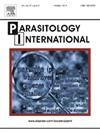Effects of wood creosote on anisakiasis: A Japanese traditional medicine as a potential tool against Anisakis larva infection
IF 1.5
4区 医学
Q3 PARASITOLOGY
引用次数: 0
Abstract
Anisakiasis has become more widely known because of the increasing popularity of raw fish consumption worldwide; it is the most common form of food poisoning in Japan. This foodborne disease has no specific treatment. Current treatments involve detecting and removing parasites that penetrate the gastric mucosa using endoscopy in medical settings. The aim of this study was to investigate the effect of wood creosote (WC) on anisakid larval movement and viability in vitro and in vivo. Using two WC concentrations, 0.67 and 6.7 mg/mL, we performed in vitro and in vivo experiments to demonstrate the effect of WC on anisakid larval movement and viability using an infrared locomotion track device and a viability scoring method. In vitro, WC effectively reduced the motility of anisakid larvae by 69.3 % at a recommended dosage of 0.67 mg/mL and killed the larvae at a higher concentration of 6.7 mg/mL. These results were supported by an in vivo experiment in BALB/c mice, in which WC, at both concentrations, reduced the motility of anisakid larvae in infected mice by more than 58.0 %. WC may become an important tool in treating anisakiasis, owing to its rapid and significant inhibitory effect on the movement and viability of anisakid larvae.

木杂酚油对异尖线虫病的防治作用:日本传统药物抗异尖线虫幼虫感染的潜在工具
由于世界范围内生鱼消费的日益普及,异鳞虫病已变得更加广为人知;这是日本最常见的食物中毒形式。这种食源性疾病没有特殊的治疗方法。目前的治疗方法包括在医疗环境中使用内窥镜检查和清除穿透胃粘膜的寄生虫。本研究旨在探讨木杂酚油(WC)对大茴香幼虫体内和体外运动和活力的影响。以0.67和6.7 mg/mL两种浓度的WC为实验材料,采用红外运动轨迹仪和活力评分法,研究了WC对大茴香幼虫运动和活力的影响。在体外,推荐用量为0.67 mg/mL时,WC可有效降低大茴香虫幼虫的运动能力,降幅达69.3%;推荐用量为6.7 mg/mL时,WC可有效杀死大茴香虫幼虫。这些结果得到了BALB/c小鼠体内实验的支持,在两种浓度的WC中,感染小鼠的八角虫幼虫的运动能力降低了58.0%以上。由于其对八角虫幼虫的运动和活力具有快速而显著的抑制作用,因此可能成为治疗八角虫病的重要工具。
本文章由计算机程序翻译,如有差异,请以英文原文为准。
求助全文
约1分钟内获得全文
求助全文
来源期刊

Parasitology International
医学-寄生虫学
CiteScore
4.00
自引率
10.50%
发文量
140
审稿时长
61 days
期刊介绍:
Parasitology International provides a medium for rapid, carefully reviewed publications in the field of human and animal parasitology. Original papers, rapid communications, and original case reports from all geographical areas and covering all parasitological disciplines, including structure, immunology, cell biology, biochemistry, molecular biology, and systematics, may be submitted. Reviews on recent developments are invited regularly, but suggestions in this respect are welcome. Letters to the Editor commenting on any aspect of the Journal are also welcome.
 求助内容:
求助内容: 应助结果提醒方式:
应助结果提醒方式:


